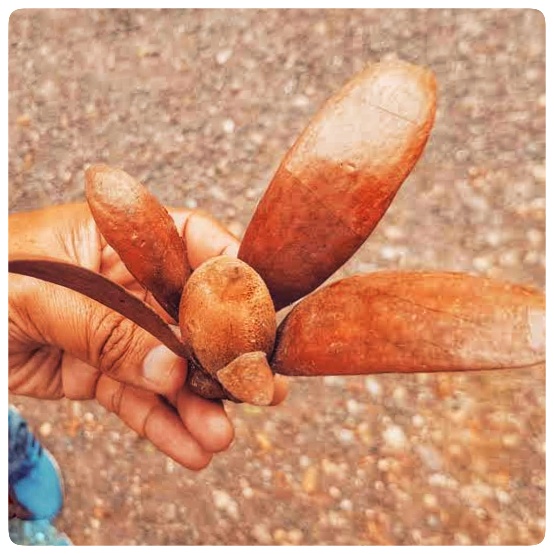Tengkawang plant profile
Tengkawang is included in the kingdom Plantae (plants), the subkingdom Tracheobionta (vascular plants), the super division Spermatophyta (producing seeds), the division Magnoliopsida (dicotyledons), sub-class Dilleniidae, order Theales, family Dipterocarpaceae, and genus Shorea. There are several types of Shorea commonly called tengkawang.
These species include Shorea amplexicaulis, S. beccariana Martelli, S. lepidota, S. macrantha, S. mecistopteryx Ridl., S. palembanica Miq., S. pinanga Sceff., S. scaberima Burck., S. seminis, S. macrophylla Ashton., S. splendida, S. stenoptera Burck., and S. sumatrana.
Benefits of Tengkawang plant
The specialty of tengkawang oil from margarine products to lipsticks
The specialty of tengkawang oil is its high melting point, which is 30ºC on average, making it suitable for the manufacture of margarine, chocolate, soap, lipstick, medicines, candles, and others (Sobari, 2001). Tengkawang seeds are one of the export commodities.
Kalimantan-Land of Tengkawang
Almost all tengkawang exports come from Kalimantan, especially West Kalimantan and a small part of East, South and Central Kalimantan (Sumadiwangsa, 1977). The existence of the economic value of tengkawang which is quite promising, is not accompanied by tengkawang conservation and replanting efforts.
Tengkawang plants are getting rare
Currently, the existence of tengkawang is threatened by the lack of natural regeneration. Data from the IUCN (International Union for Conservation of Nature) Red List Categories of Threatened Species in 2014, has included several types of tengkawang as protected species. S. macrophylla is included in the category that is facing a high risk of extinction in the wild (Vulnerable) A1cd, S. macrantha is included in the category that is facing a very, very high risk of extinction in the wild (Critically Endangered) A1cdC2a, as well as S. palembanica, S. sumatrana, S. lepidota and S. seminis are in the (Critically Endangered) A1cd status, while S. stenoptera and S. splendida are in the category of facing very high risk of extinction in the wild (Endangered) A1cd.
Save tengkawang species
Seeing the tengkawang conditions above, it is necessary to carry out efforts to save the tengkawang species. Many rescue efforts have been carried out by various parties, including the Ministry of Forestry through the Forestry Research and Development Agency in which the Yogyakarta Center for Biotechnology Research and Forest Plant Breeding is included. The Yogyakarta Center for Biotechnology Research and Forest Plant Breeding has started a rescue effort through the construction of an ex-situ conservation area of 3.5 hectares of tengkawang species in Tahura Ngargoyoso, Karanganyar, Central Java.
 |
In addition, a shift in the way of thinking about using tengkawang to not only use wood but also tengkawang as a non-timber forest product will greatly support the rescue effort. |



